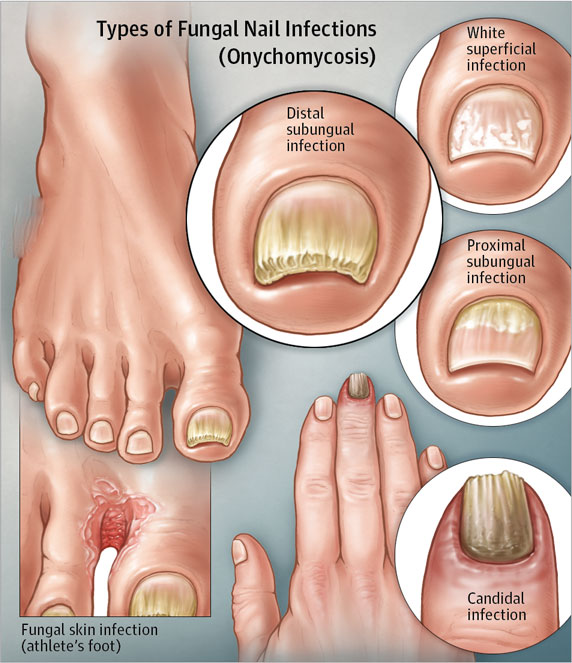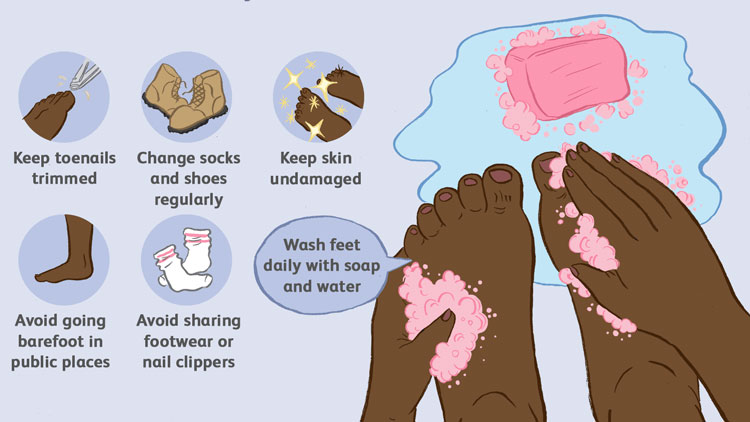Nail fungus is a common condition that begins as a white or yellow spot under the tip of the toenail. Nail fungus is also called Onychomycosis.
Fungal nail infections can develop when various organisms such as molds, yeasts, and fungi come into contact with a cracked nail or skin surrounding the nail. Fungal infections normally develop over time. This nail fungal infection can affect several nails. It may cause your nail to discolor, thicken and crumble at the edge.
SYMPTOMS
Nail fungus can affect more commonly in toenails. If you have any of the following conditions on your nail, you may have a nail fungus infection.
If one or more of your nails are:
- Thickened
- Whitish to yellow-brown discoloration
- Brittle, crumbly, or ragged
- Distorted in shape
- A dark color, caused by debris building up under your nail
- Smelling slightly foul

CAUSES
There are many different causes of toenail fungus infection. Each cause has its own treatment.
Fungal nail infections can develop in people at any age. Toenail fungal infection can start from an athlete’s foot, and it can spread from one nail to another.
The warm, moist environments help the fungus to develop naturally. While doing manicures and pedicures and the tools such as emery boards and nail clippers are not sanitized, they can spread fungal infections from person to person.
Also, there are other factors such as poor blood circulation to the feet and a weak immune system.
TREATMENT
Foot fungus won’t just go away on its own, it needs proper medication and treatment. If your condition is mild and not bothering you, you don’t require any treatment.
If your nail fungus is painful and has caused thickened nails, treat them fast to stop the spread and avoid serious problems. Even after successful treatment, nail fungus often comes back.
Your doctor may advise antifungal drugs that you can take orally or apply to the nail.
- Oral antifungal drugs – These drugs clear the infection more quickly. The terbinafine (Lamisil) and itraconazole (Sporanox) help a new nail grow slowly and free of infection.
- Medicated nail polish – You can use an antifungal nail polish called ciclopirox (Penlac). You have to paint it on your infected nails and surrounding skin. You must use this type of nail polish daily for almost a year.
- Medicated nail cream – This antifungal cream rubs into your infected nails.
- Surgery – Your doctor might recommend the temporary removal of the nail so you can apply the antifungal drug directly to the infected area. Some fungal nail infections don’t respond to medicines, that time you need nail removal surgery.
You can apply a lotion to thin nails which contain urea.

HOME REMEDIES FOR TOENAIL FUNGUS
A variety of treatment options for toenail fungus are available. Some home remedies are most effective for nail fungus infection.
- Wear clean socks and shoes.
- Soaking feet in plain black tea.
- Hydrogen peroxide can kill fungus.
- Soak your foot in baking soda.
- Soaking feet in magnesium sulfate.
- Regular exercise.
- Apply Cornmeal on fungus infection or a soak.
RISK FACTORS
Nail infections occur more in men than in women, and in adults more than in children. There are some factors that can increase your risk of developing nail fungus.
- Being older or over age 65
- Poor blood flow or circulation problems
- Sweating heavily
- Slower growing nails
- History of athlete’s foot
- Walking barefoot in damp communal areas, such as swimming pools, gyms, and shower rooms
- Minor skin or nail injury
- Having diabetes
- Skin injury around the nail
- Moist fingers or toes for an extended time
If you have diabetes and a fungal nail infection, it’s important to see your doctor. If you or anyone experiencing toenail fungus Infection, feel free to visit Specialty Care Clinics.
Talk to our expert podiatrist. Call us at (469) 545-9983 to set up an appointment.
